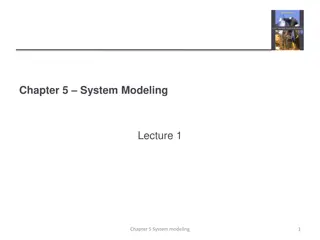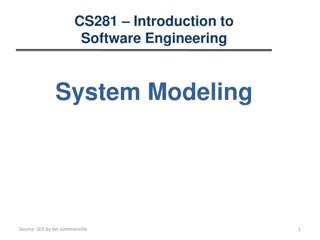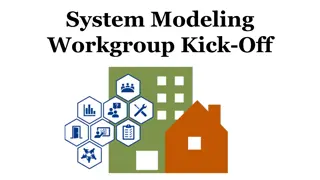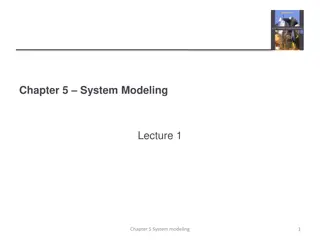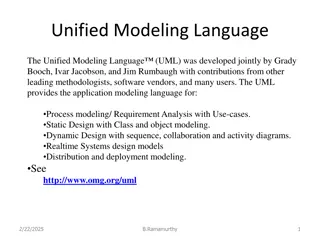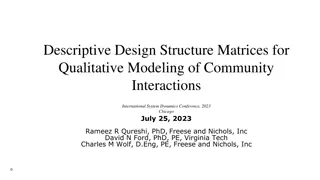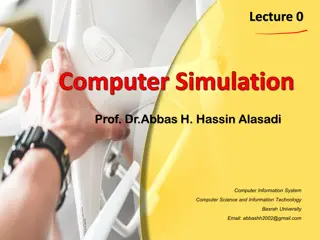Overview of Army Modeling and Simulation Office
The U.S. Army Modeling and Simulation Office (AMSO) serves as the lead activity in developing strategy and policy for the Army Modeling and Simulation Enterprise. It focuses on effective governance, resource management, coordination across various community areas, and training the Army Analysis, Mod
3 views • 8 slides
Capacity Zone Modeling for Forward Capacity Auction 17 Results
This presentation unveils the Capacity Zone modeling calculations for Forward Capacity Auction 17 associated with the 2026-2027 Capacity Commitment Period by ISO-NE PUBLIC. It delves into boundary definitions, import-constrained zone modeling, and market rules guiding the assessments and modeling pr
5 views • 16 slides
Distribution Feeder Modeling and Analysis Overview
This document delves into the modeling, optimization, and simulation of power distribution systems, specifically focusing on Distribution Feeder Modeling and Analysis. It covers the components of a typical distribution feeder, series components, Wye-Connected Voltage Regulator modeling, and equation
12 views • 14 slides
Evolution of Modeling Methodologies in Telecommunication Standards
Workshop on joint efforts between IEEE 802 and ITU-T Study Group 15 focused on information modeling, data modeling, and system control in the realm of transport systems and equipment. The mandate covers technology architecture, function management, and modeling methodologies like UML to YANG generat
3 views • 16 slides
Geometric Modeling in CAD
Geometric modeling in computer-aided design (CAD) is crucially done in three key ways: wireframe modeling, surface modeling, and solid modeling. Wireframe modeling represents objects by their edges, whereas surface modeling uses surfaces, vertices, and edges to construct components like a box. Each
3 views • 37 slides
System Modeling in Engineering
System modeling in engineering involves developing abstract models to represent a system from various perspectives using graphical notations like UML. These models aid in understanding system functionality, communicating with stakeholders, and documenting requirements for new systems. Existing and p
9 views • 53 slides
Mathematical Modeling and Error Analysis in Engineering
Mathematical modeling plays a crucial role in solving engineering problems efficiently. Numerical methods are powerful tools essential for problem-solving and learning. This chapter explores the importance of studying numerical methods, the concept of mathematical modeling, and the evaluation proces
10 views • 10 slides
Introduction to Dynamic Structural Equation Modeling for Intensive Longitudinal Data
Dynamic Structural Equation Modeling (DSEM) is a powerful analytical tool used to analyze intensive longitudinal data, combining multilevel modeling, time series modeling, structural equation modeling, and time-varying effects modeling. By modeling correlations and changes over time at both individu
6 views • 22 slides
System Modeling and Simulation Overview
This content provides insights into CPSC 531: System Modeling and Simulation course, covering topics such as performance evaluation, simulation modeling, and terminology in system modeling. It emphasizes the importance of developing simulation programs, advantages of simulation, and key concepts lik
4 views • 28 slides
Object Modeling in Software Development
Object modeling is a crucial concept in software development, capturing the static structure of a system by depicting objects, their relationships, attributes, and operations. This modeling method aids in demonstrating systems to stakeholders and promotes a deeper understanding of real-world entitie
4 views • 65 slides
Coupled Ocean-Atmosphere Modeling on Icosahedral Grids
Coupled ocean-atmosphere modeling on horizontally icosahedral and vertically hybrid-isentropic/isopycnic grids is a cutting-edge approach to modeling climate variability. The design goals aim to achieve a global domain with no grid mismatch at the ocean-atmosphere interface, with key indicators such
6 views • 21 slides
Fire and Smoke Modeling Evaluation Effort (FASMEE) Overview
FASMEE is a collaborative project aimed at assessing and advancing fire and smoke modeling systems through critical measurement techniques and observational data. Led by key technical leads, FASMEE focuses on diverse modeling areas such as fire growth, effects, coupled fire-atmosphere behavior, smok
9 views • 30 slides
Subarea and Highway Corridor Studies: Travel Demand Modeling and Refinements
In this lesson, we delve into subarea and corridor studies focusing on travel demand model refinements, highway network coding, corridor congestion relief, and trip assignment theory. Subarea modeling plays a crucial role in forecasting travel within smaller regions with detailed traffic patterns, t
4 views • 45 slides
Essential Steps for Setting up a Modeling Study
Ensure clarity on modeling goals and uncertainties. Select sample areas strategically based on interest and available data. Determine appropriate resolution for modeling. Define variables to model and validate the model effectively. Assess sample data adequacy and predictor variables availability. E
1 views • 9 slides
Water Storage Tanks Hydraulic Modeling and Water Quality Considerations
This presentation by Justine Carroll, P.E., Project Manager, focuses on the hydraulic modeling and water quality considerations related to water storage tanks. It covers topics such as water age evaluation, steady state modeling, extended period simulations, pump controls, demand patterns, EPS verif
3 views • 34 slides
Advancing Computational Modeling for National Security and Climate Missions
Irina Tezaur leads the Quantitative Modeling & Analysis Department, focusing on computational modeling and simulation of complex multi-scale, multi-physics problems. Her work benefits DOE nuclear weapons, national security, and climate missions. By employing innovative techniques like model order re
4 views • 6 slides
Flexible Framework for Stormwater Lids Modeling
A new flexible framework for forward and inverse modeling of stormwater lids is presented. It includes governing equations, hydraulic and contaminant transport, numerical methods, and demonstration cases for various green infrastructure components. The importance of different processes in modeling i
4 views • 20 slides
Sustainability and Organic Livestock Modeling for Global Food Security
The research presented at the 18th Organic World Congress in Istanbul delves into the Sustainability and Organic Livestock (SOL-m) modeling approach developed by FAO and FiBL. The study aims to explore the potential impacts of global conversion to organic livestock production by 2050 on food securit
2 views • 25 slides
Update on Modeling and Coordination Discussions
Weekly coordination calls with Ramboll and discussions with EPA OAQPS leads focused on Regional Haze and modeling adjustments. Final draft of procedures document with visibility projections and glide slope adjustments. Upcoming RTOWG meetings covering methodology, projections, and modeling evaluatio
2 views • 5 slides
Importance of Data Modeling in Industrial Information Systems
Introduction to data modeling and design in Industrial Information Systems at King Saud University College of Engineering. The chapter covers the significance of data modeling, capturing data characteristics, structural information, and the role of databases and DBMS. Data modeling fills crucial gap
4 views • 51 slides
Mega-Modeling for Big Data Analytics
Mega-Modeling is a comprehensive approach that encompasses model construction, evaluation, composition, evolution, and search to address challenges in various areas such as social and economic resilience, health, transportation, and energy management. The pillars of Mega-Modeling include Model-Drive
7 views • 14 slides
System Modeling in Software Engineering
System modeling in software engineering involves developing abstract models of a system to understand its functionality and communicate with stakeholders. Models are used in requirements engineering, design proposals, and system documentation. Different perspectives like external, structural, intera
0 views • 35 slides
NetLogo - Programmable Modeling Environment for Simulating Natural and Social Phenomena
NetLogo is a powerful and versatile programmable modeling environment created by Uri Wilensky in 1999. It allows users to simulate natural and social phenomena by giving instructions to multiple agents operating independently, making it ideal for modeling complex systems evolving over time. NetLogo
0 views • 7 slides
System Modeling for Homeless Response: Kick-Off Meeting Insights
Explore the key aspects of the system modeling workgroup's kick-off meeting, including agenda highlights, discussions on system modeling goals and purpose, developing a shared vision, and even a fun pizza activity that ties back to the homeless response system. Gain insights into the structured proc
0 views • 30 slides
Reservoir Modeling Using Gaussian Mixture Models
In the field of reservoir modeling, Gaussian mixture models offer a powerful approach to estimating rock properties such as porosity, sand/clay content, and saturations using seismic data. This analytical solution of the Bayesian linear inverse problem provides insights into modeling reservoir prope
1 views • 10 slides
System Modeling Overview and Perspectives
System modeling involves developing abstract models of a system to represent different perspectives. It helps in understanding system functionality, communicating with customers, and generating system implementations. Different perspectives such as external, interaction, structural, and behavioral a
4 views • 26 slides
Unified Modeling Language - Application Modeling for Software Development
Unified Modeling Language (UML) is a powerful tool developed by Grady Booch, Ivar Jacobson, and Jim Rumbaugh for modeling various aspects of software development. It encompasses phases like requirement analysis, object-oriented design, system development, and testing. Use-case modeling and component
2 views • 18 slides
SPP Future Energy and Resource Needs Study Summary
Capacity expansion modeling approach outlined in the SPP Future Energy and Resource Needs Study (FERNS). The study focuses on determining the most cost-effective future resource mix to meet system needs through 2050 under various electrification and carbon-free generation pathways. It addresses ques
2 views • 11 slides
Open-Source Energy System Modeling at TU Wien
This presentation explores the advantages and challenges of open-source energy system modeling, highlighting the low barriers to entry and democratization of research it offers. It discusses practical considerations for setting system boundaries, delves into the scenario space of Shared Socioeconomi
3 views • 16 slides
Data Modeling and Simulation by Dr. Fadi M. S. Alsuhimat
This presentation covers topics such as performance evaluation, simulation modeling, system taxonomy, terminology, simulation modeling development, advantages of simulation, and more. It delves into the concepts, processes, and benefits of data modeling and simulation in various systems and environm
1 views • 11 slides
Qualitative Modeling for Community Interactions in System Dynamics
Explore how qualitative modeling techniques can effectively represent complex community interactions in system dynamics, addressing challenges in system analysis and formal modeling. Discover solutions to represent various system components and interactions for an enhanced system overview.
2 views • 18 slides
Discrete Event Modeling vs. Agent-Based Modeling: A Comparative Analysis
Explore the differences between discrete event modeling and agent-based modeling in this informative presentation. Discover how these modeling approaches vary in defining system behavior, individual autonomy, and global outcomes, with real-world examples and accompanying research paper. Understand t
4 views • 8 slides
Introduction to Computer Modeling and Simulation for Graduate Students
This course overview provides insights into computer modeling and simulation for graduate students in various disciplines. It covers the importance of system modeling, analytical skills development, and practical applications. With a focus on scientific thinking and experimentation, students will ex
7 views • 21 slides
NoSQL Data Modeling Techniques
Explore the world of NoSQL data modeling, from key-value stores to document and graph databases. Learn how NoSQL modeling differs from relational modeling, the importance of application-specific queries, and various techniques like denormalization and hierarchical modeling. Discover how different No
5 views • 45 slides
Interconnect Modeling with Lumped Elements: Basics and Impedance Fundamentals
Explore the fundamentals of interconnect modeling using lumped elements in digital system design, covering modeling techniques, impedance characteristics of resistors, capacitors, and inductors, and understanding the importance of impedance in system analysis. Enhance your knowledge of circuit model
3 views • 26 slides
Interactive Detailing Tool for Strength Modeling System
This project focuses on developing a tool for interactive detailing of object areas within the strength modeling system. Addressing challenges such as preservation of geometric features, scalability, and user-friendliness, the tool aims to offer a comprehensive solution for modeling complex objects.
4 views • 27 slides
Modeling Biological Systems Workshop 2014 | Welcome & Agenda
Welcome to the 2014 CMACS Workshop on Modeling Biological Systems! Join us for a day filled with introductions, agenda discussions, and insightful information sharing on mathematical modeling techniques, tools, and more. Explore the subject matter of modeling signaling pathways and enhancing your in
0 views • 20 slides
Architectural Modeling: Components and Physical Representation
Explore the world of architectural modeling with a focus on components and their physical representation in software-intensive systems. Learn about logical and physical modeling, UML components, and common modeling techniques to shape your system effectively.
2 views • 35 slides
Power System Modeling Updates and Notifications
Stay informed about power system modeling updates with the NERC System Analysis Modeling Subcommittee (SAMS) as they identify and notify industry of obsolete models, such as the EX2000 Dynamics Component Model, Gas Turbine Governor Modeling, and more, ensuring reliability and compliance with standar
0 views • 6 slides
Physical Modeling & Dimensional Analysis in Physics
Explore the world of physical modeling and dimensional analysis in physics, including the importance of experiments, mathematical modeling, validation, and system of physical dimensions. Learn about key figures, principles, theorems, and non-dimensional quantities relevant to experimental modeling.
1 views • 12 slides





